The Sebring 12 Hours, held annually at the Sebring International Raceway in Florida, is one of the most storied endurance races in the world. Its origins trace back to 1952 when the first race was organized by a group of American sports car enthusiasts. The event was initially conceived as a way to showcase the burgeoning American sports car culture, and it quickly gained traction among both competitors and spectators.
The race was held on a former World War II airfield, which provided a unique and challenging layout that combined both asphalt and concrete surfaces, a characteristic that would come to define the event. Over the decades, the Sebring 12 Hours has evolved into a key fixture on the international motorsport calendar. It became part of the FIA World Endurance Championship in 2012, further solidifying its status as a premier endurance race.
The event has witnessed numerous technological advancements in automotive engineering, with manufacturers pushing the boundaries of performance and reliability. From the early days of simple sports cars to the modern prototypes and GT machines, the evolution of vehicles competing at Sebring reflects broader trends in the automotive industry. The race has also been a proving ground for innovations that have trickled down to consumer vehicles, making it a significant event not just for motorsport fans but for car enthusiasts worldwide.
Key Takeaways
- Sebring 12 Hours is a historic endurance race held at Sebring International Raceway in Florida, with a rich history dating back to 1952.
- Endurance racing at Sebring is a thrilling test of both man and machine, with teams pushing their limits for 12 hours straight.
- The race has seen legendary drivers such as Mario Andretti, A.J. Foyt, and Dan Gurney, who have left their mark on the event.
- Intense competition at Sebring 12 Hours is fueled by teams from various racing series, including IMSA WeatherTech SportsCar Championship and World Endurance Championship.
- The Sebring circuit is known for its challenging layout, featuring bumpy concrete and asphalt surfaces that test the skills of drivers and the durability of cars.
The Thrill of Endurance Racing
The Unpredictable Nature of Endurance Racing
The thrill of endurance racing lies in its unpredictability; mechanical failures, weather changes, and driver fatigue can all play pivotal roles in determining the outcome. The psychological aspect of endurance racing cannot be overstated. Drivers must contend with physical exhaustion while maintaining mental acuity for hours on end.
The Art of Pacing
The race is as much about pacing as it is about speed; drivers must find a balance between pushing their limits and conserving energy for later stages of the race. This dynamic creates an exhilarating atmosphere, where every lap can bring new challenges and opportunities.
The Human Element of Endurance Racing
Fans are drawn to this unpredictability, as they witness not just a battle of machines but a test of human endurance and ingenuity.
The Legendary Drivers of Sebring

Throughout its history, the Sebring 12 Hours has been graced by some of the most legendary drivers in motorsport. Icons such as Juan Manuel Fangio, Carroll Shelby, and Mario Andretti have all left their mark on this prestigious event. Each driver brought their unique style and approach to racing, contributing to the rich tapestry of Sebring’s history.
For instance, Fangio’s mastery of car control and strategic thinking allowed him to excel in various racing conditions, while Shelby’s tenacity and engineering prowess helped elevate American sports cars on the global stage. In more recent years, drivers like Tom Kristensen and Scott Dixon have continued this legacy, showcasing their skills in high-pressure situations. Kristensen, often referred to as “Mr.
Le Mans,” has also made significant contributions at Sebring, demonstrating his versatility across different endurance races. Dixon’s ability to adapt to various racing formats has made him a formidable competitor at Sebring, where he has secured multiple victories. These drivers not only embody the spirit of competition but also serve as inspirations for aspiring racers who dream of one day competing in this iconic event.
The Intense Competition at Sebring
| Year | Number of Teams | Number of Drivers | Number of Laps |
|---|---|---|---|
| 2021 | 37 | 111 | 348 |
| 2020 | 32 | 96 | 349 |
| 2019 | 35 | 105 | 348 |
The competition at the Sebring 12 Hours is fierce, with teams from around the globe vying for supremacy. Manufacturers invest heavily in research and development to create vehicles that can withstand the grueling demands of endurance racing. This investment is evident in the diverse array of cars that take to the track each year, from high-performance prototypes to production-based GT vehicles.
The presence of multiple classes racing simultaneously adds another layer of complexity to the competition, as teams must navigate traffic while executing their race strategies. The intensity of competition is further heightened by the presence of factory-backed teams alongside privateers. Factory teams often have access to cutting-edge technology and resources, while privateers rely on ingenuity and determination to compete at the highest level.
This dynamic creates an environment where every second counts; a small mistake can lead to significant consequences in terms of position and points. As teams battle for supremacy on the track, they also engage in a psychological game, analyzing competitors’ strategies and adapting their own plans in real-time.
The Spectacular Sebring Circuit
The Sebring International Raceway is renowned for its challenging layout and unique characteristics. Spanning 3.74 miles, the circuit features a combination of long straights and technical corners that test both driver skill and vehicle performance. The track’s surface is a mix of asphalt and concrete, which can lead to varying grip levels throughout the race.
This variability adds an element of unpredictability that keeps drivers on their toes and requires constant adjustments to their driving style. One of the most iconic features of the Sebring circuit is its history as a former airfield. The remnants of runways and taxiways create a distinctive atmosphere that sets it apart from other racetracks.
The circuit’s elevation changes and challenging turns demand precision driving, making it a favorite among competitors who relish the opportunity to showcase their skills. Additionally, the picturesque Florida landscape provides a stunning backdrop for both participants and spectators alike, enhancing the overall experience of attending this legendary race.
The Fan Experience at Sebring
The Sebring 12 Hours offers an unparalleled experience for fans, drawing thousands from around the world to witness this thrilling event. The atmosphere is electric, with fans camping out for days leading up to the race, creating a vibrant community filled with camaraderie and shared passion for motorsport. The accessibility of the circuit allows fans to get up close to the action, with opportunities to explore paddocks, meet drivers, and even participate in fan events that enhance their connection to the sport.
In addition to the racing itself, Sebring offers a variety of entertainment options for fans. Live music performances, food vendors featuring local cuisine, and merchandise stalls create a festival-like atmosphere that complements the excitement on track. Fans can engage with interactive displays showcasing automotive technology and history, further enriching their experience at this iconic event.
The combination of thrilling racing action and engaging fan activities makes attending the Sebring 12 Hours a memorable experience for motorsport enthusiasts.
The Importance of Strategy in Endurance Racing
Strategy plays a crucial role in endurance racing, where teams must make critical decisions that can impact their chances of success over long distances. From tire selection to fuel management, every choice made during the race can have significant consequences. Teams must carefully analyze data from practice sessions and qualifying runs to develop a comprehensive race strategy that accounts for variables such as weather conditions and track evolution.
Pit stops are another critical aspect where strategy comes into play. Teams must execute flawless pit stops to minimize time lost during refueling or tire changes while also considering driver changes. A well-timed pit stop can provide a competitive advantage, allowing teams to gain positions on track or respond effectively to competitors’ strategies.
As races unfold over several hours, adaptability becomes essential; teams must be prepared to adjust their plans based on real-time developments during the race.
The Future of Sebring 12 Hours
As motorsport continues to evolve, so too does the future of the Sebring 12 Hours. With advancements in technology such as hybrid powertrains and electric vehicles gaining traction in endurance racing, Sebring is poised to embrace these changes while maintaining its rich heritage. Manufacturers are increasingly investing in sustainable technologies that not only enhance performance but also address environmental concerns associated with motorsport.
Moreover, as fan engagement becomes increasingly important in sports, organizers are exploring innovative ways to enhance the spectator experience at Sebring. This includes leveraging digital platforms for live streaming and interactive content that allows fans to connect with their favorite teams and drivers in real-time. As new generations of fans emerge, maintaining relevance while honoring tradition will be key to ensuring that the Sebring 12 Hours remains a cornerstone of endurance racing for years to come.
The future holds exciting possibilities for this iconic event as it continues to adapt to changing times while celebrating its storied past. With each passing year, the Sebring 12 Hours promises not only thrilling competition but also an enduring legacy that captivates motorsport enthusiasts around the globe.








Leave a Reply